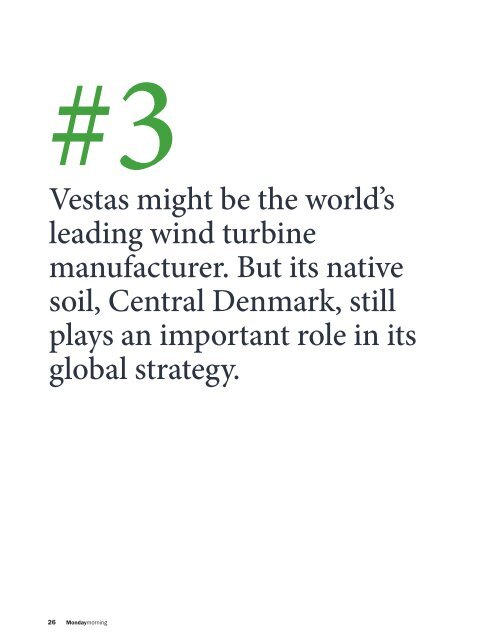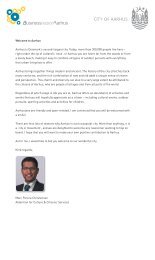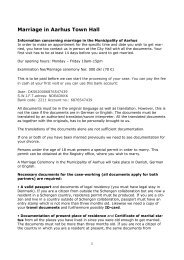Aarhus – Capital of Wind Energy - Aarhus.dk
Aarhus – Capital of Wind Energy - Aarhus.dk
Aarhus – Capital of Wind Energy - Aarhus.dk
- No tags were found...
You also want an ePaper? Increase the reach of your titles
YUMPU automatically turns print PDFs into web optimized ePapers that Google loves.
#3Vestas might be the world’sleading wind turbinemanufacturer. But its nativesoil, Central Denmark, stillplays an important role in itsglobal strategy.Vestas:The Grand Old Man<strong>of</strong> the Industry• The world’s largest wind turbine manufacturer, Vestas, is in the process <strong>of</strong> moving its headquarters to <strong>Aarhus</strong>• The roller coaster history <strong>of</strong> the company is representative <strong>of</strong> the development <strong>of</strong> the Danish wind turbineindustryOver the last 30 years, the wind giant Vestas has slowlymigrated from its home town <strong>of</strong> Lem on the western coast<strong>of</strong> Denmark, through Ringkøbing and Randers to <strong>Aarhus</strong>,where its new corporate headquarters is scheduled to openin 2011. In the course <strong>of</strong> this 114 kilometres journey, thecompany has undergone a exceptional transformation,from a small forge to a global wind energy market leader.It has kept facilities on its native soil in the Ringkøbing-Skjern area. But by and large, it is a global operator witharound 22,000 employees around the world, a marketshare <strong>of</strong> 12.5 percent and a turnover <strong>of</strong> 49.4 billion kronerin 2009. Since Vestas produced its first turbine in 1979,the company has installed over 40,000 turbines around theworld. Today, it erects a new turbine every three hours.Vestas can claim the credit for almost a third <strong>of</strong> the world’scombined wind power capacity over the last thirty years.The Beginning: LemThe story <strong>of</strong> Vestas begins in 1898, when 22-year-oldHans Søren Hansen bought his local forge and foundedhis company. Right from the beginning, the enterprisewas engaged to windmills, servicing the numerous Danishfarms where small mills powered threshers and similarmachinery. But its main product was steel window framesfor industry.During WWII, the company went bankrupt due to alack <strong>of</strong> raw materials, but already in 1945, the founder’sson, Peter Hansen, founded VEstjyske STaalvarefabrik A/S(West Jutland Steel Factory Inc.), shortened “Vestas”. Initially,it produced household machines, but slowly turnedto farm vehicles and small cranes for trucks.The oil crisis <strong>of</strong> the 1970s brought political attention toenergy security. Concording with the spirit <strong>of</strong> the times,Vestas commenced its first wind turbine experiments. In1979, Vestas developed its tall, three-bladed trademarkturbine, simply known as the ‘Danish Concept’ in the industry.The design which conquered the world and is theindustry standard even today.Interest in wind turbines was modest in the beginning,mainly stemming from communes and small, alternativefarmers. In 1980, Vestas had 36 orders for wind turbines.The introduction <strong>of</strong> highly advantageous American taxschemes which contributed up to 50 percent <strong>of</strong> the price <strong>of</strong>the turbines, changed this and created what has since beenreferred to as the ‘Great Californian wind rush’. In 1983,Vestas’ orders rocketed from around 30-40 per year to 155.Within a year they, had 550 orders, and in 1985s, they sent1,200 turbines across the Atlantic.In 1986. the American market suddenly collapsed asa new political agenda put a stop to the tax rebates. Thisspelled disaster for Vestas, which applied for an administrationorder. On January 7th 1987, Vestas was declaredtechnically bankrupt. The wind turbine adventure <strong>of</strong> the1980s was over.The Recovery: RingkøbingOn the same day, Vestas rose from the ashes for a secondtime with the founding <strong>of</strong> Vestas <strong>Wind</strong> Systems A/S. Withjust 60 employees, it set out on a remarkable recovery.The bankruptcy had taught the company a valuablelesson, and Vestas began to forge new markets so that itwould never be dependent on one clientele again. A jointventure with India was established, and Vestas openedsales <strong>of</strong>fices in Germany, Sweden, the US and Italy. Slowly,turnover began to grow from 100 million kroner in 1987 to500 million kroner in 1990.26 Mondaymorning <strong>Aarhus</strong> <strong>–</strong> <strong>Capital</strong> <strong>of</strong> <strong>Wind</strong> <strong>Energy</strong> 27




